Binding of N-methylscopolamine to the extracellular domain of muscarinic acetylcholine receptors
- PMID: 28091608
- PMCID: PMC5238504
- DOI: 10.1038/srep40381
Binding of N-methylscopolamine to the extracellular domain of muscarinic acetylcholine receptors
Abstract
Interaction of orthosteric ligands with extracellular domain was described at several aminergic G protein-coupled receptors, including muscarinic acetylcholine receptors. The orthosteric antagonists quinuclidinyl benzilate (QNB) and N-methylscopolamine (NMS) bind to the binding pocket of the muscarinic acetylcholine receptor formed by transmembrane α-helices. We show that high concentrations of either QNB or NMS slow down dissociation of their radiolabeled species from all five subtypes of muscarinic acetylcholine receptors, suggesting allosteric binding. The affinity of NMS at the allosteric site is in the micromolar range for all receptor subtypes. Using molecular modelling of the M2 receptor we found that E172 and E175 in the second extracellular loop and N419 in the third extracellular loop are involved in allosteric binding of NMS. Mutation of these amino acids to alanine decreased affinity of NMS for the allosteric binding site confirming results of molecular modelling. The allosteric binding site of NMS overlaps with the binding site of some allosteric, ectopic and bitopic ligands. Understanding of interactions of NMS at the allosteric binding site is essential for correct analysis of binding and action of these ligands.
Figures

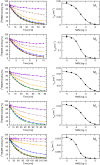
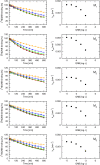



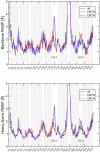


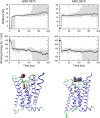
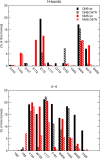

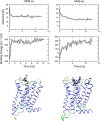



Similar articles
-
New insight into active muscarinic receptors with the novel radioagonist [³H]iperoxo.Biochem Pharmacol. 2014 Aug 1;90(3):307-19. doi: 10.1016/j.bcp.2014.05.012. Epub 2014 May 23. Biochem Pharmacol. 2014. PMID: 24863257
-
Modes of allosteric interactions with free and [3H]N-methylscopolamine-occupied muscarinic M2 receptors as deduced from buffer-dependent potency shifts.Naunyn Schmiedebergs Arch Pharmacol. 2000 Dec;362(6):512-9. doi: 10.1007/s002100000316. Naunyn Schmiedebergs Arch Pharmacol. 2000. PMID: 11138843
-
Subtype selectivity of the positive allosteric action of alcuronium at cloned M1-M5 muscarinic acetylcholine receptors.J Pharmacol Exp Ther. 1995 Sep;274(3):1077-83. J Pharmacol Exp Ther. 1995. PMID: 7562472
-
Multiple allosteric sites on muscarinic receptors.Life Sci. 2001 Apr 27;68(22-23):2517-24. doi: 10.1016/s0024-3205(01)01047-5. Life Sci. 2001. PMID: 11392621 Review.
-
Allosteric regulation of muscarinic receptors.Prog Brain Res. 1996;109:147-51. doi: 10.1016/s0079-6123(08)62096-8. Prog Brain Res. 1996. PMID: 9009701 Review. No abstract available.
Cited by
-
Allostery of atypical modulators at oligomeric G protein-coupled receptors.Sci Rep. 2021 Apr 29;11(1):9265. doi: 10.1038/s41598-021-88399-x. Sci Rep. 2021. PMID: 33927236 Free PMC article.
-
Predicting Residence Time of GPCR Ligands with Machine Learning.Methods Mol Biol. 2022;2390:191-205. doi: 10.1007/978-1-0716-1787-8_8. Methods Mol Biol. 2022. PMID: 34731470
-
Current Advances in Allosteric Modulation of Muscarinic Receptors.Biomolecules. 2020 Feb 18;10(2):325. doi: 10.3390/biom10020325. Biomolecules. 2020. PMID: 32085536 Free PMC article. Review.
-
Acetylcholine Neurotransmitter Receptor Densities in the Striatum of Hemiparkinsonian Rats Following Botulinum Neurotoxin-A Injection.Front Neuroanat. 2018 Aug 10;12:65. doi: 10.3389/fnana.2018.00065. eCollection 2018. Front Neuroanat. 2018. PMID: 30147647 Free PMC article.
-
Recessive CHRM5 variant as a potential cause of neurogenic bladder.Am J Med Genet A. 2023 Aug;191(8):2083-2091. doi: 10.1002/ajmg.a.63241. Epub 2023 May 22. Am J Med Genet A. 2023. PMID: 37213061 Free PMC article.
References
-
- Bonner T. I. The molecular basis of muscarinic receptor diversity. Trends Neurosci 12, 148–51 (1989). - PubMed
-
- Eglen R. M. Overview of Muscarinic Receptor Subtypes In Handb exp pharmacol (eds Fryer A. D., Christopoulos A. & Nathanson N. M.) pp. 3–28, Springer (2012). - PubMed
-
- Jakubík J. et al. Outline of therapeutic interventions with muscarinic receptor-mediated transmission. Physiol Res 63 Suppl 1, S177–89 (2014). - PubMed
Publication types
MeSH terms
Substances
LinkOut - more resources
Full Text Sources
Other Literature Sources

